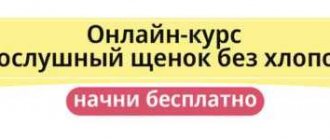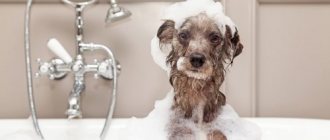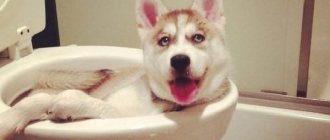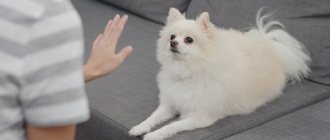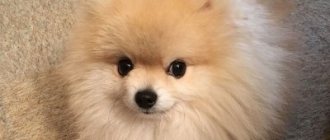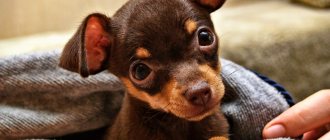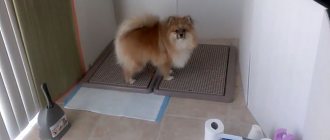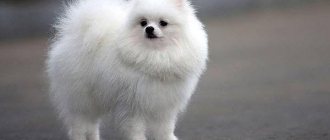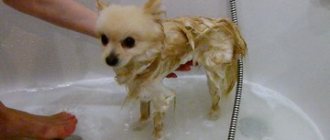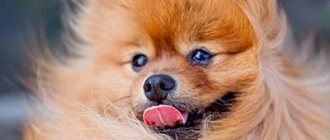- Preparing a place for a pet
- Adaptation of a puppy to a new family
- Nutrition
- Vitamins, microelements, food additives, treats
- Health
- Grooming
- Features of girls
- Education and socialization
You have become the proud owner of the best furball, this is wonderful!
But now your task is to raise him into a healthy, beautiful, well-mannered and socialized family member! How to do this correctly? This is exactly what my article is about! Also, in short, in it we will touch on the main important points: how not to spoil the health of the Spitz yourself, how not to spoil the dog’s psyche, how not to miss the training time, how to raise a future champion.
So, the basics:
Preparing a place for a pet.
Your baby has already been reserved and you are looking forward to his wonderful arrival in your family. You need to prepare for his arrival:
- 1.1.
Place.
The lounger or mattress can be chosen solely at your discretion, since it is almost impossible to predict whether the future owner will like it or not! In new families, babies very quickly change their habits and adapt to the wishes of their new owners. They also very skillfully use any indulgences and, for example, if you allow your pet to sleep with you or with your child in the bed, then the puppy is unlikely to exchange this opportunity even for the most delightful sofa of his own! In addition, many of our graduates generally prefer to sleep or relax simply on the floor covering, because it is cooler for them or it is simply convenient to fall asleep where they were. But in any case, you should have your own place! And where exactly to arrange it is a more important question. Here it is necessary to take into account that the dog should always have access to it, regardless of your presence or absence at home. Under no circumstances should there be a draft there and it is highly desirable that there be a good overview of everything that is happening in the house.
- 1.2.
Dining room.
Includes two 200-250 ml bowls on a low stand (10-15 cm is enough), and a rubberized mat if you have expensive or slippery flooring. It is advisable that the dining room be located not far from the bedroom, but always in the same room.
- 1.3.
Feed.
Don’t forget to ask us in advance what kind of food you will need and where to purchase it with our nursery discount.
- 1.4.
Equipment.
It sounds threatening, but in fact, the most inexpensive soft harness, adjustable in diameter under the chest from 20 to 30 or more cm, will be enough, because you will not need it for long until the baby adapts to the new place and switches to a collar. We will show you in the nursery which collar is suitable for the Japanese Spitz.
- 1.5.
Cosmetics and hygiene.
This set will also be minimal at the first stage. When the baby arrives, you will need absorbent diapers, since with a high probability the child will go to the bathroom on them, despite the fact that in the nursery we do not teach them to do this. We do not recommend purchasing everything else in advance. If you have not yet been to our kennel, when you meet, we will clearly demonstrate what exactly, what quality and at what period of life the dog will need and how to choose the right one.
- 1.6.
Toys.
We recommend buying in advance only a few toys made of solid rubber, silicone and ropes, this is exactly what our babies play with from the moment they start teething, and in the future you can go to the pet store together and there the child will choose for himself what exactly he likes. Many people prefer balls, and some only like soft animals and play with them very carefully, but you still shouldn’t leave them unattended.
With this the preparations are complete, we move on to the main points when the long-awaited baby is finally home!!!
Dog character
The Pomeranian Spitz is a miniature but very brave dog . She is curious, playful and loyal. A feature of this breed is the desire to constantly be surrounded by people. However, she is distrustful of strangers: she can bark and show the guest with all her appearance that he is not welcome here.
The Spitz's businesslike gait, upright posture and important appearance - all these external characteristics indicate that this pet is very wayward and requires constant care and attention from the owner.
This is a good guard. The Spitz shows amazing courage when it comes to protecting its territory. However, this dog is devoid of any aggression: it does not bite or attack. Her main trump card in protecting her place and owner is her loud barking.
Spitz are very sensitive creatures. Any rustle or sharp sound can alert or frighten them. When stressed, a dog begins to bark loudly. From an early age, the owner needs to accustom him to order and obedience so that the Pomeranian does not voice without reason, otherwise his barking will be heard constantly in the house.
The dog is very active , so it needs to be walked often. She loves to run in the fresh air and accompany her owner during jogging and walks in the park. This creature plays with the same zeal at home. The Spitz must have his own toys that he can chew on, otherwise he may pay attention to shoes and upholstered furniture.
Spitz dogs make excellent companions for active people. You won't get bored with such a dog! She will always be there, demanding attention, walks and games. In addition, the Pomeranian gets along well with other pets and children.
You should not indulge all the whims of this cute creature, otherwise you risk losing your authority. In this case, the Spitz will begin to treat the owner as an equal, and this should under no circumstances be allowed. During the training process, it is important to accustom the dog to a place and a tray.
Adaptation of a puppy to a new family.
So, the baby has crossed the threshold of your home for the first time. You are surprised how calmly he endured the journey, has already become attached to you and feels quite confident in the new place, since in the Donik Style nursery great attention is paid to the psyche in breeding work and at the rearing stage.
But despite this, do not forget that everything is completely new for the child! It is very important to surround the little member of your family with as much love and care as possible from the first minute! You shouldn’t punish your baby at all during the first week; it’s enough to simply calmly explain what is required of him and encourage correct behavior (we’ll talk about suitable treats later).
Try to spend as much time with him as possible, pick him up at every opportunity (don’t forget the main thing yourself and be sure to remind your children that under no circumstances should you lift a puppy, just like an adult dog, by the paws or under the armpits, where the delicate ligaments are located) . Don’t be shy to talk to a Japanese person and don’t doubt that he understands you, despite the fact that he still knows few words. Remember, dogs do not communicate verbally, so it doesn’t matter what language you speak, what matters is how you do it, what gestures and intonations you use to reinforce your speech, and what you want to convey.
Immediately from the road, pour water, show the place, give toys and after a short time feed the baby. Place a diaper on the place where he goes to the toilet; in the future, if necessary, it can be moved to where it is convenient. When the need arises to leave the little one alone, unattended, be sure to make sure that he does not have access to anything that can be chewed and choked, be it slippers, any soft things, household appliances, and especially live wires. Don’t forget, when teeth grow, they itch, and the most unexpected things can come into play!
If at this stage you still have questions or the puppy’s behavior worries you, be sure to contact us!
List of necessary things
After all the listed practical recommendations, it would be useful to provide a list of things that you will need to buy before getting a pet. Some of them were mentioned above, but for clarity, let’s summarize all the tips in one list:
- a house or a lounger is a place for your pet to rest. Remember that Pomeranians love protected shelters where they feel safe;
- An aviary is an excellent option for walking your pet. At the same time, make sure that the size of such an enclosure is sufficient for the dog to feel free;
- toys - they must be soft and safe, so metal and plastic are completely excluded;
- food – ask the breeder about which variety you should buy;
- food bowl;
- tray;
- brushes for grooming;
- nail clipper to care for claws;
- a special toothbrush and toothpaste;
- carrying;
- clothes - do not forget that small dogs are cold, so in cold and damp weather, like people, they need clothing;
- leash, collar and muzzle;
- first aid kit
Nutrition:
- 3.1. We recommend feeding your puppy exclusively with super premium dry food. What kind of food currently meets all the needs of our dogs and corresponds to the declared quality - we will inform you before purchasing a puppy, as we regularly conduct an independent examination of all products used in our kennel and constantly analyze the condition of the dogs. Important! If for some reason you think that the food we recommend is not suitable for your pet, contact us and together we will select an alternative food! Under no circumstances should you suddenly change the food (the transition, if necessary, occurs with gradual mixing for at least two weeks) or start trying everything. The selection of food is a very serious issue and requires professional study, taking into account all the individual characteristics of the dog, as well as its parents and their nutrition, on the one hand, and a detailed check of the manufacturer, as well as the quality and composition of the product, on the other, regardless of the stated indicators and the Internet reputation.
- 3.2. Up to five to six months, the puppy should be fed 4 times a day, the interval between evening and morning meals should not exceed 12 hours. After that, you need to switch to three meals a day. The interval between night and morning meals can be increased to 14 hours, and only after the dog is fully formed, usually after 1.5-2 years, and sometimes later, (depending on the size and type of maturation of your new family member) you can switch to two meals a day nutrition.
- 3.3. Below is an approximate table of the daily ration norm, in grams. This amount must be divided by the number of feedings to determine the amount of food for each feeding for your puppy. But at the same time, you still need to monitor the child’s condition, he should not be too plump, the ribs should be palpable well enough, but not stick out, the tummy should not sag. The puppy should eat quietly, but not leave anything in the bowl. If he does not chew the food, but swallows it, at the next feeding you can slightly increase the portion, but if the puppy has not finished eating, the food should be removed until the next meal. At some feedings, the puppy may eat more greedily, and at others reluctantly, all this must be taken into account, since all babies are individual, and even, like us, can be “night owls” or “larks”. Also, keep in mind that a few days after moving to a new home, the pet will most likely begin to eat worse and may even refuse to eat at some feedings. Don’t panic, this is due to the fact that healthy competition has disappeared, and the cunning one realized that if you are capricious, the food will still not go anywhere, but something tasty may fall through the cracks! Further proper nutrition or lack thereof will depend on which of you has the stronger character! If the baby digs for a long time or demonstratively refuses, simply remove the bowl until the next feeding and under no circumstances give anything else or even treats until the entire main diet has been eaten. If the baby does not eat throughout the day, this is a cause for concern, measure the temperature and contact us.
Small breed puppies (1-10 kg) Puppy weight Puppy age 3-12 weeks 3-6 months 6-10 months 1-2 kg 60-120 g 30-85 g 30-70 g 3-4 kg 100-190 g 85-150 g 70-110 g 5-6 kg 250-285 g 160-190 g more than 8 kg - 3.4. It is better to feed the puppy from a stand. Its height is adjustable as the puppy grows. When the puppy's head is lowered into the bowl, the neck should not rest against it, but the back should be straight and the paws should be parallel. If the puppy places them, it means the bowl is set too low, but if he arches his neck and stretches, then it’s too high. And most importantly, don’t forget, it is very IMPORTANT that FRESH WATER IS AVAILABLE ROUND THE CLOCK!!!
Remember, you took not just a puppy, but a tiny baby into your home! Be very patient, kind and attentive with him. Don't be angry or annoyed - your patience and love will pay off handsomely.
1. General recommendations.
Remove any small objects that your puppy might swallow.
Make electrical wires inaccessible.
Keep all chemicals away. Do not give toys with accessories that the puppy can chew off.
Don't leave your puppy alone on the bed.
Do not feed your puppy from the table.
Do not allow guests to pick him up and treat him.
Hold your puppy when you open the front door for someone to help prevent them from escaping.
When leaving the puppy at home alone, lock him in one room or use an enclosure (pen) so that the puppy does not harm himself in any way.
The puppy may be very frightened by the sounds of firecrackers, fireworks, shots, thunder - pick him up and take him to a quiet place.
2. Feeding the puppy.
It is necessary to feed the puppy 3-4 times a day, depending on age, with soaked dry food. According to the instructions, in accordance with age, the daily intake should be divided into 3-4 feedings (choose the optimal amount for yourself and stick to it constantly). Uneaten soaked food cannot be stored for more than 2 hours. From 8 months The puppy can be fed 2 times.
From other foods, you can only give children kefir, vegetables, fruits - all in very small quantities! Do not provoke allergies and gastritis.
In case of whims: you have to be consistent - they put food on, ate - they removed the empty bowl, if they didn’t eat - they removed it and gave it back 1 hour later. There is no need for food to sit all day. If the puppy does not eat, it means that he is not hungry, and there is no need to replace it with anything. Especially natural food.
You can switch from soaked food to dry food only by 4 months. It is necessary to transfer within 14 days, gradually reducing the time of soaking the feed.
You can switch your puppy to dry food from another company no earlier than 5 days after the puppy arrives at your home (a period of stress will pass). Carry out the transfer within 5 days by mixing new food with the old one, observing the puppy’s stool and well-being. Use only premium and super premium food. The transfer of feed should not coincide with the quarantine period during vaccination.
You can switch to natural food no earlier than 5 days after the puppy arrives at your home (a period of stress will pass). We strongly recommend feeding your puppy ready-made food for up to a year!
The puppy should be well-fed, but not fat (to avoid joint deformation) - its ribs should be palpable through a thin layer of fat. Increase or decrease the portion depending on the physical condition of the puppy.
Water is always freely available. Use only boiled or purified water. If you give your dog bottled filtered water, then add 1 teaspoon of mineral water per 200 ml. filtered water is useless.
3. Puppy teeth and care for them.
The first change of teeth in small breed puppies begins after 4.5 months. The incisors begin to wobble and fall out. At this time, it is good to give the puppy special toys for removing milk teeth, very large beef bones (tibia joints, vertebrae, etc.).
If a tooth does not fall out, but a molar is already visible under it, then it is necessary to urgently remove this tooth to preserve the bite. Contact your veterinarian. By 6 months the fangs are changing, proceed in the same way.
4. Protecting your puppy from parasites.
Remember that if a puppy has fleas, he will definitely have worms! Therefore, treatment must be carried out first against fleas, then after 3-4 days against worms. It is recommended to give 30 minutes before treatment. 1/6 tab. suprastina.
A puppy that has been taken out for walks must be treated regularly. Up to 6 months Give anthelmintic once every 3 months. And according to the instructions, treat with flea and tick repellents. After 6 months deworm once every six months. Treat your dog against fleas and ticks regularly according to the instructions.
A puppy that does not go outside also needs treatment, because... he can still become infected (from neighbors' animals, from street dirt on shoes). Treat a puppy that is not walking with anthelmintic once every six months.
5. Treats.
Ready-made treats in pet stores from veins and the like are not recommended to be given to a puppy under 4 months. Don't get carried away with them. You can give a little at a time. Make sure your puppy doesn't choke. It is good to give large beef bones (vertebrae, shin joints, etc.), cook for 5 minutes. Do not give completely cooked bones; the puppy will be able to bite them through.
Chicken bones are dangerous! Chocolate is poison!
Pieces of vegetables and fruits can serve as treats.
6. Care of fur and claws.
Try to carry out combing, nail trimming, and teeth cleaning procedures at more than one time. It is best to do this when the puppy has had enough of playing and clearly wants to sleep.
Trim your nails every 2 weeks.
From 3 months The puppy's coat gradually changes to that of an adult. The puppy will shed a lot - don't be alarmed. He may start to itch frequently. The final coat of long-haired breeds is established only by 2 years! At the same time, girls shed very often: in the off-season, before or after estrus. You need to help the puppy's coat change to an adult one by brushing the puppy 2 times a week and washing it once every 10 days.
After the puppy's fluff comes off, it is necessary to wash it as often as the tummy will seem dirty. Use high quality puppy shampoos and conditioners. Rinse off the shampoo and conditioner thoroughly to prevent your puppy from itching. After washing, the puppy’s coat must be dried with a hairdryer, a warm stream, and a massage comb, row by row. Undried skin and fur cause diaper rash and scratching. Train your puppy patiently and persistently; he will get used to all procedures only if you do not allow him to break out and behave badly.
Brush your puppy's coat thoroughly 2-3 times a week, spraying it with a special product or puppy balm diluted with water (1:12). When your puppy grows up, visit the groomer (hairdresser) periodically, then your dog will look well-groomed.
When your puppy's teeth change, he may experience bad breath. Teach your puppy to brush his teeth first with just a brush, and then with a special toothpaste. Small breed dogs develop tartar very quickly; regular brushing will prevent it.
7. Puppy vaccination.
Vaccination follows the standard schedule. Vaccination of a puppy is carried out only in a veterinary clinic or at an appointment with a kennel veterinarian. Before vaccination, anthelmintic is given 5-7 days according to instructions. The day before and on the day of vaccination it is necessary to give the puppy 1/6 tablet of Suprastin. Don’t forget to give your veterinary passport to your doctor to confirm your vaccination.
8. Pedigree.
The puppy card can be exchanged for a pedigree until the puppy is 15 months old. After this, the puppy card becomes invalid. To exchange it for a pedigree, you can contact any kennel club, our kennel or personally at the RKF in Moscow.
9. Hypoglycemia.
The smaller the dog, the higher the risk of attacks of hypoglycemia (a pathological condition characterized by a decrease in glucose levels). Symptoms: excessive salivation, weakness and drowsiness, refusal to feed, apathetic state. Acute form: convulsions, fainting, paralysis of limbs.
The reason is hunger, unbalanced food. Very often, hypoglycemia occurs as a consequence of another problem, as a side effect. For example, if a puppy has diarrhea or vomiting and loss of appetite for a completely different reason, an attack of hypoglycemia may immediately occur.
Elimination. No matter how scary the acute form of hypoglycemia may look, the problem is quite easy to eliminate. Immediately inject 5% glucose, or if this is not possible, immediately give the dog a drink of very sweet warm water. If your puppy refuses to drink, you need to force at least 3-4 teaspoons of sweet water into him.
10. Diarrhea in a puppy.
A puppy's normal stool should be a soft, sausage-shaped stool. If the puppy begins to have diarrhea (mushy, watery), then it is necessary to give it water or soak the food in rice water for 1 day. Give him Rehydron or mineral water without gases so that he does not become dehydrated. If diarrhea does not stop for more than 2 days, go to the vet immediately! If diarrhea during the day is accompanied by vomiting, contact the vet immediately!
11. Games with a puppy.
Never pull a toy out of your puppy's mouth, this can easily ruin his bite! Avoid giving your puppy very small toys to prevent him from swallowing them. Avoid giving soft toys with plastic eyes and noses - your puppy will easily chew them off and swallow them.
To prevent your puppy from getting bored with toys, divide the number of toys into three parts. Give him some in the morning, then take it away, give him another part in the evening, etc. Do not play with your puppy with your hands, but only with toys, and then he will not bite.
12. Team "Ugh!" and punishment.
If the puppy is gnawing on something forbidden, sternly and sharply say “Ugh!” and immediately lure him away from this place with a toy. If the puppy still returns to the scene of the “crime” and continues to misbehave, repeat the command and slap him in the face with a rolled-up newspaper. Remember - first the command, and then the punishment! Spanking without a command can frighten the puppy. Instead of newspaper, you can use a water gun or a spray bottle of water.
Author Viktorova S. (When copying, a link to this page is required!)
Vitamins, microelements, food additives, treats.
- 4.1. Your food is a completely balanced diet for dogs as a whole. Your puppy received everything additionally necessary for good health and proper formation in our nursery, up to four months of age. IMPORTANT! NO ADDITIONAL DRUGS, ESPECIALLY CALCIUM CONTAINING, should not be given without medical prescriptions! The best is the enemy of the good, and an excess of most vitamins and microelements, and especially calcium, can sometimes be much more dangerous than a deficiency, since in the latter case the body is able to produce them itself (though sometimes, taking them from the bones, so a blood test will not show this deficiency ), but the excess is often not excreted, but is deposited in the body, causing intoxication and other very serious problems. So, the main thing is to find a middle ground, which we did experimentally.
- 4.2.
Treats.
We recommend using dried tripe as a treat and to encourage correct behavior. This is a 100% natural product that contains all the substances that are beneficial for dogs, unlike most artificial treats, especially those cooked from intestines, which have undergone a lot of processing and can cause allergies, and even poisoning, in large quantities. Raw, rough-processed tripe is also very useful. If you know a farmer or butcher and you can stand the “delicate” smell of this delicacy, you are lucky! But before use, the tripe must be cut into small cubes or strips and deep frozen in special bags. This treat should be given after it has been defrosted naturally, preferably before bedtime, but after switching to food for adult dogs. Natural vegetables and fruits can also be used as a treat, but not with food. Which ones exactly - the puppy will tell you himself. Surely everything that grows on your site will be to his taste, especially apples and pears in season; some people really like berries. In winter, it can be cabbage, seaweed is especially good, which in winter is also a good preventative for the so-called “winter nose” (not to be confused with a lack of pigment), carrots and even potato peelings, if these are your own potatoes (do not give the potatoes themselves). costs). Fruits such as grapes and raisins cannot be given; bananas are not needed. Naturally, all this can be given in very moderate quantities, so as not to cause upset and fill the stomach instead of the main diet.
Health.
You purchased a puppy from the professional kennel Donik Style, where only absolutely healthy dogs that have been tested for the absence of genetic diseases are allowed for breeding.
At the time of moving, your puppy is completely healthy, vaccinated according to the optimal schedule and treated for parasites. The quarantine is over, and his health is not in danger. In order to continue to avoid health problems throughout the life of your Japanese friend, you need to regularly examine your pet and under no circumstances postpone standard preventive actions, which we will discuss below.
We strongly recommend that you keep a diary of planned events on the first day of your baby’s birth. It is very important in the near future to get to know one of the doctors you like at your local veterinary station, even if you have a good “own” veterinarian. Only this will allow you to receive prompt information about the increased activity and infestation of dangerous tick diseases in your area and reliable information about breakdowns in certain drugs and vaccines. And also, if necessary, provide immediate assistance when every minute counts, as for example in cases of poisoning with scattered poisons. If, God forbid, you need some kind of qualified assistance, we will recommend proven specialists for each specific case, if any are available in our database in your region.
- 5.1.
Treatment for blood-sucking parasites.
Ticks pose a huge danger as they are carriers of a very large number of diseases, including fatal ones! Fleas and mosquitoes are also extremely dangerous, especially because they carry helminth larvae, including those that attack the animal's heart. Your dog should be treated for fleas and ticks strictly monthly, as soon as the snow melts in your region and until late autumn, until stable night frosts set in. We recommend using drops on the withers that correspond to the weight and age of the dog. They must be applied strictly to the skin, for which it is necessary to part the hair on the back from the withers to the tail with a thin comb. Drops should be applied to at least two places on the withers and closer to the tail. At the moment, there is a very large assortment of these drugs on the market, but very often one has to deal with unscrupulous manufacturers and counterfeits, so it is not so much the manufacturer’s brand that is important, but confidence in the quality of the drug. It is optimal if it is possible to purchase these drugs abroad for the entire season (sold in all human pharmacies at a separate stand) or check with supply managers where the drug is imported from. If you are not sure of the authenticity, it is better to use proven drugs from domestic manufacturers. We recommend alternating different medications for blood-sucking and worms throughout the year.
- 5.2.
Deworming.
That is, getting rid of worms. Your puppy began receiving anthelmintic drugs from early childhood according to a certain regimen. His parents additionally received an anthelmintic two weeks before mating, and the mother and the babies were treated three times. The growing and walking areas of puppies and dogs on the territory of our kennel are also constantly treated with special preparations, but even these comprehensive measures cannot guarantee that the puppy will not be infected with helminth eggs, since they are found everywhere! In this regard, you should not forget that your dog should receive preventive medications throughout its life, unless severe infestation is detected (in which case veterinary treatment is already necessary). This treatment is carried out in favorable conditions at least 2 times a year, and in high-risk conditions (urban environment, access of foreign animals, missed flea treatment, addition of raw fish and meat to food) - quarterly. The drugs should be alternated, since they are developed against different types of helminths, mainly nematodes and cystodes. There are also broad-spectrum drugs, but as a rule they are more toxic, so you should not overuse treatments with them alone. The most well-proven drugs are Melbimax, Kanikquantel, Drontal plus, Durofen (domestic manufacturer), as well as complex antiparasitic drugs for fleas, ticks, mosquitoes and worms - Advantix, Bayer and Stronghold companies - Pfizer (USA), which are the prevention of heart dirofilariasis in dogs, which are especially recommended for use in places where mosquitoes are infested! NECESSARILY! Deworming is carried out 12-14 days before vaccination, do not forget about this when you create an annual treatment schedule for your friend!
- 5.3.
Vaccinations.
Even if your baby has already arrived with all the necessary vaccinations and completed quarantine, do not forget to add a reminder to your calendar that no later than 1 year after the last vaccination, which includes the rabies vaccine, you must repeat the vaccination! If you still have to get your last vaccination, take it very seriously, since when revaccinating, each specific day and drug are of fundamental importance! Do not violate the schedule prescribed by the breeder, even if it contradicts the requirements of your country. Unfortunately, these standards are often driven by a commercial component and may contradict each other in different countries. Important!!! Don’t forget that 2 weeks before vaccination, the puppy must be treated for worms!
- 5.4.
Claws.
From the first days of life, we shaped the claws of our puppies so that the vessel would not pass too close to the end of the claw. Therefore, with proper maintenance and walking, the claws on your dog’s paws mostly grind down on their own. Nevertheless, their condition must be checked monthly, because if the nails are too long, they interfere with the correct assembly of the paw, which negatively affects the dog’s gait and appearance, and as a result, its overall health. IMPORTANT! Don’t forget about the claws on the dewclaws on the front paws, as they don’t wear down at all, unlike all the others, and if you don’t take care of this issue, the claw can grow in, which will lead to surgery! You can trim the claws yourself with a special nail cutter, but in such a way as not to touch the vessel, as this can cause very heavy bleeding and cause pain to the dog (be sure to have a special hemostatic agent on hand) and fear of this procedure in the future. You can also file them down with a rough human foot file, this will take much longer - but it’s safe, or the third option is to take your friend to a pet salon, where professionals will do this. The latter option will have an additional beneficial effect on the socialization of your child.
- 5.5.
Ears and Eyes.
Your dog's eyes and ears are a mirror of his health! In a healthy state, the eyes are clean, clear and with a sparkle. There are no discharges and we managed to remove tear tracks from our breeding. The inside of the ears is also absolutely clean, even if you have never wiped them, and they smell very tasty. If in the morning or during the day you notice purulent accumulations in the corner of your eyes, gluing of eyelashes (a small dark lump that easily comes off from the fur - this is not considered, since it is a normal waste product), or if you lift your ear, you see redness, irritation, or a small rash there or just an unpleasant smell - this is a cause for concern! Contact us immediately! Healthy ears do not need preventive treatment; moreover, wiping without indication destroys the natural protective layer, so there is no need to do this! Wipe the fur around the eyes - on the contrary, you should make it a rule from childhood, as soon as you see a tear. A slight tearing in the wind, from food vapors, during meals and in the morning, after sleep is completely normal, but since the coat of our dogs is snow-white, a stable tear stone appears on it within a few days, and will disappear naturally only after half a year, during moulting. We strongly do not recommend removing it with special means widely available on the market, because more often than not they lead to exactly the opposite effect, causing regular tearing due to their toxicity. You need to wipe your eyes with a dry cosmetic napkin (without lint). If the discharge has dried, wash it off with silver water first, to obtain which you just need to put a silver spoon in a glass container with spring or well water (it is important that it is not tap water, without chlorine) a day before use. This habit will also allow you to promptly notice lint or other foreign particles in the eye, which can cause severe tearing and prevent this trouble. Remember! It is incomparably easier to prevent the appearance of unsightly tear tracks under the eyes through simple but regular care than to get rid of those that have already appeared!
- 5.6.
Teeth.
Manufacturers of modern dry food are very actively working on new formulas and even forms of granules designed to reduce plaque and tartar formation. Cunning businessmen are also very actively using this problem, widely advertising all sorts of treats that magically remove all the stones at once, but miracles do not happen and you need to monitor the condition of your dog’s teeth throughout his life. Plaque causes bad breath, and tartar leads to gum disease and tooth loss, the consequences of which I don’t think need to be explained. From childhood, teach your puppy to show his teeth on demand without any resistance; this will be especially useful for those who will be engaged in a show career. To remove plaque, take a bandage, moisten it with chlorhexidine and thoroughly wipe all teeth on all sides. If a stone is detected, it must be removed mechanically yourself, but extremely carefully so as not to damage the gums, or take it to a specialist. You need to wipe off plaque on your teeth monthly; we recommend having your teeth professionally cleaned as needed, but not more than twice a year.
Pomeranian Spitz nursery
The first thing I want to say is that you don’t need to run to the market and buy everything that is offered to you. Start by preparing the space where the puppy will be. It should be as safe as possible. Remove and hide all wires (he will definitely chew them) There should be no sharp or sharp objects on the floor. Everything that is on the floor will immediately end up in the baby’s mouth. Fence all descents (stairs). While you are not at home, it is advisable for your baby to limit his space (playpen) - this way he and your things will be safe. You need to organize three corners for the puppy - where he will sleep, eat and relieve his needs. The rest of the space will be his play space. place to sleep . Some people just like to sleep on the floor, some like a purchased lounger, some like a closed space and sleep in a carrier or under the bed. And some are only on the bed and with the owner. Give the dog the opportunity to make his own choice. If you don’t want her to sleep on the bed with you, don’t teach her to do this in the first place – don’t take her to the bed even when you’re not sleeping. Ideally, do not allow the dog to be on the bed or sofa - because... Spitz have weak paws, and any jump, even from a small height, can be tragic. The place for eating should be permanent. There should be two plates: for water, a larger volume, and for food. Water should be constantly available, food - according to feeding time according to age. Anything that is not eaten should be removed before the next feeding. I don't like iron bowls. Of all of them, I loved the ceramic ones the most – they are heavy. They don't move while eating. Easy to clean. You can buy it at a regular dishware store. It is desirable that the bottom is not narrow. Salad bowls will do. The place for peepee is a diaper. There are disposable and reusable ones that can be washed. I use the size 60x90. The puppy can mistake everything that lies on the floor - rags, carpets - for a diaper and relieve itself there. Therefore, at first it is advisable for the puppy to be in a space where there is nothing on the floor. At the same time, the floor should not be slippery (laminate, parquet, linoleum) - because this leads to improper development of the legs. I put old bedspreads on the floor that can be washed. At first, the puppy should be rewarded for choosing the right place for peepee. Thus, you accustom him to the diaper. There should be several diapers and gradually reduce their number. Immediately after sleep, you take the puppy to the diaper and try to get him to do his business in it.
The puppy should have enough toys. Over time, you will see which toys your dog prefers and there will be no problems with the choice. Before changing the puppy's teeth, only soft toys are recommended. Tug games are prohibited!!! What toys did my dogs love: No competition - a bun. Manufactured by TRIXIE BagelsandRolls, Bagels and Rolls Latex Toys. Various balls, strings, all types of soft toys. They also enjoy playing with available materials - rags, gloves, paper (can be rolled into a ball). The main principle is to make sure that the toy is safe. For example, if you give a ball made of paper, make sure that the puppy does not eat it while playing.
Collar. If the puppy is already 3 months old, has received all vaccinations and has passed quarantine, then you can already take him for a walk. You should not take him out right on the first day of arrival - let him get comfortable and get used to you. If you have the opportunity to walk in a fenced area, that’s great! And you don't need any collars. But sooner or later you will have to go outside, so it is necessary to accustom him to a collar. A Spitz needs a special collar - leather, round, with the seam inside. This is the one that wipes the fur the least. To go with the collar you need to buy a tape measure - a leash. A three-meter one is enough for me and I prefer a cord rather than a ribbon. I like TRIXIE. Combs. Already in the first days you will need to tidy up the puppy's coat. You need to scratch as often as possible - once a day, twice. When the fur changes to an adult one, it can be done less often – once every 3-7 days. What combs are needed - read in the “hair care” section.
Grooming.
The Japanese Spitz's coat is truly self-cleaning if kept in a healthy condition, so you won't need frequent washing or special skills. Before the first real shedding (7-11 months, depending on the time of year, climate and individual characteristics), it is enough to comb the puppy against the grain with a soft slicker brush. This should be done at least as often as the fluff on the elbows or hips will have time to matt on the dry fur. When the first hair appears, and not fluff, you will need to arm yourself with a comb with longer teeth, a brush and comb your friend every day during this period in order to avoid turning everything else in the house into a Japanese Spitz in color.
The best option is to wash your handsome dog at this time, but be sure to wash it for the first time either in the presence of a professional or in a salon where they dealt with Japanese Spitz dogs. (Warn the groomer, just in case, that your puppy is from a professional nursery, has a pedigree fur coat, and therefore the Japanese Spitz is not only not required to cut anything, but is not even allowed, except for properly rounding the paws around the feet, if necessary!).
You can only wash a fully groomed dog, you need to use professional cosmetics, and be sure to blow out the hair with a compressor!
Drying with a human hairdryer and leaving the fur wet is not possible if you want to keep it well-groomed and in show condition. There is also no need to use balms and conditioners for the healthy coat of the Japanese Spitz. When you dry your dog, try to touch the fur as little as possible with your hands so as not to make it greasy. Use a brush with bristles to lift and dry strictly against the growth of the hair.
Cosmetics exist for regular use and for exhibition preparation. Which one we recommend to use and how - we will show you when you pick up the puppy, please remind us about this.
It is not necessary or even advisable for Japanese Spitz to wear overalls in winter, because natural heat exchange is disrupted. They are not afraid of any frost, and snow has a very beneficial effect on their fur coat. But it is imperative to protect your paws from reagents and salt if you are walking in the city. For this purpose, there are protective creams for paw pads that do not contain water. After a walk in such conditions, you should definitely wash your paws with a special moisturizer. You should wear boots only as a last resort and with great care, as the dog can slip and pull a ligament, and this is a very unpleasant and long-healing injury. In the off-season, if your pet gets dirty, just let the fur dry and comb it against the grain with a slicker to restore its original whiteness.
Pomeranian puppy - first day in a new home
Home / For future owners / Pomeranian Spitz / Pomeranian Spitz puppy – first day in a new home
Select a breed to view articles about it:
- Yorkshire Terrier
- Chihuahua
- Pomeranian Spitz
Having made a choice and decided to buy a Spitz puppy, you should prepare in advance for the fact that the first day the pet spends in a new place will be quite difficult for both the tiniest creature and its owner. Often, only after bringing the baby into the house does the new owner understand what responsibility he has taken on, because Spitz puppies require attention, daily care and a serious approach to education.
So, before you bring your chosen baby into the house, you need to purchase the following things: - prepare a house for the puppy, choose a place where he will sleep, be sure to be away from drafts. A house for a Pomeranian can be bought at a specialized store, or you can simply prepare a fairly soft and at the same time easily washable bedding. By the way, the best bedding would be the owner’s old thing, which retains his smell - this way the baby will quickly get used to the new home, and the owner’s smell will be associated with comfort and safety. Some owners prefer to set up a place for the puppy in the kitchen, next to the water and food bowls. The main thing is that the baby is comfortable enough and in the future, if the dog persistently prefers another place to sleep, you should listen to the animal’s opinion; - specialized food for puppies, but if you decide to feed your dog food from your table, you need to make sure that he has enough vitamins and that the food is sufficiently varied and healthy; — dishes for water and food should be easy to clean and comfortable for a small puppy, so you shouldn’t get carried away with deep and too wide bowls; — a comb is a must-have attribute that will be needed for daily care of the thick coat, which is the real pride of this breed. Spitz puppies need daily brushing, only in this case they will look well-groomed and elegant; - shampoo for hair care, a tray (for boys it is better to prefer a tray with a column), but special diapers or panties for girls can be purchased a little later, when the time of the first heat approaches.
It is also worth learning about the frequency of vaccinations, purchasing special literature, and also psychologically preparing for the fact that a new resident will appear in the house, requiring attention and care.
First day and night in a new place
Often the first problems can appear already on the road. Very young Pomeranian puppies can get motion sickness, so be prepared that your baby may vomit in the car, in which case it is better to stop and let the dog get some fresh air for a couple of minutes. Having brought the baby home, you must immediately show the already prepared place and leave the dog alone - let him familiarize himself with the situation. It is necessary to remember that Spitz puppies, despite their miniature size, are not toys at all; you cannot constantly carry a dog in your arms, overly pamper and take care of it. You should immediately prohibit children from treating your baby like a soft toy - Pomeranian puppies have their own character, and their independence, perseverance and courage cannot be underestimated. On the first night, the puppy may “cry” - whine and howl, in this case you need not to feel sorry for him, but to calm him down, you can close the door to the kitchen, leaving the baby a bowl of water and food. By showing firmness from the first day a dog appears, you can achieve greater success in training than by indulging all the whims and stubbornness of the animal.
The main thing is to remember that buying a Spitz puppy means becoming the owner of an extremely devoted, affectionate, but at the same time persistent and active creature, raising and communicating with which will require a lot of effort, time and patience.
Features of girls.
If you are the happy owner of a girl, don’t worry, it won’t cause any particular inconvenience or discomfort, as our girls are incredibly clean! You just need to take into account the following points:
- 7.1. The first heat will occur in the interval of 7-9 months, less often 6 or 10, depending on the individual developmental characteristics of the child. When you notice scarlet blood (not dark) on the girl’s pants, it will be considered the first day. Be sure to write this date in your beauty’s diary. Estrus lasts 21 days. Repeated with an interval of 6 months (less often 5-7), if this interval is more or less, taking into account that you have one female individual, it is a deviation, but do not worry ahead of time, contact us for a more detailed consideration of the issue.
- 7.2. There is no need to wear any sanitary panties during the period of estrus. Even if the baby doesn’t react to the discharge during the first few days, show her the marks on her panties and the instinct to lick herself will definitely kick in. Hygienic panties will be a hindrance to this, and will also disrupt the natural temperature regime.
- 7.3. Remember, no matter what you may read on the Internet, that all days of estrus are “dangerous”, and therefore, under no circumstances should you let a girl off the leash for the entire estrus period, even if she is very obedient and comes at the first call ! A male can jump up and stand in a lock in a matter of minutes and severely injure the baby if he turns out to be larger, in addition to an unwanted pregnancy and the possibility of infection.
Education and socialization.
Dear friends, we have carefully taken care of the correct heredity of your new friend and his adaptation to life in society at an early stage of development, however, what kind of relationship you will develop in the future and how socialized the dog will be depends ONLY ON YOU!
- 8.1. The most important thing that is required of you is to establish a completely trusting relationship with the puppy from the first day (we partially discussed this issue in paragraph 2 of this article). If your relationship is built on love, you will not have to make any additional efforts to achieve everything you want from your Japanese Spitz! This is a dog that does not require punishment to raise! The Japanese happily try to please in everything and please their owner. Their intelligence allows them to remember and carry out all your commands with one explanation.
- 8.2. The only points in the education of which you must show particular persistence and rigor are the categorical prohibition of picking up anything on the street or taking from strangers and crossing the curb of the road! How to do this correctly, if you do not have your own experience, is described in detail by many famous dog trainers in the world, the most important thing is to be patient and consistent! We do not recommend putting on a muzzle to stop picking up on the street, because for thinking dogs, consciously made decisions are the most effective.
- 8.3. If for some reason your pet’s relationship with you or someone in your family does not work out - giving your Japanese Spitz for personal lessons with an instructor is an ineffective activity, it would be more correct to take a course in teaching you how to communicate with a dog from a dog handler or animal psychologist. The second option is to undergo group OKD. (general training course) In this case, if you plan to engage in a show career, be sure to warn the instructor about this in order to exclude the “sit” command from the training. The third option is to do ring training with a handler. This will allow you to kill two birds with one stone, establish contact with your pet and prepare it for exhibitions. (we will talk more about exhibitions in the corresponding article) The last option is also the most effective for socialization!
- 8.4. The concept of socialization includes the dog’s adaptation to a situation that is unfamiliar and uncomfortable for it. Therefore, the more often you take your pet with you to a variety of different and noisy places, with large crowds of people and animals, the calmer and more adequate his behavior will be in the future. Believe me, even if at first the baby is scared and uncomfortable, then very soon he will get used to it and will be very grateful to you for taking him with you and not leaving him alone at home.
If you still have specific questions about animal psychology and behavior correction, as well as on any other points, do not hesitate to contact us for a more detailed consultation! We wish you only positive emotions from communicating with your new family member and a lot of happiness! With respect to all visitors.
The author of the manual is the head of the nursery Donik Style, Victoria Schislyaeva.
Parenting Tips
The character of a pet directly depends on how to raise it - in this, dogs are no different from people. Below we provide a list of recommendations for raising a puppy:
- The Pomeranian Spitz is a miniature breed, one of the important advantages of which is the ease of solving the toilet problem. It is not necessary to take such a dog outside; in bad weather, it can easily use the litter box if it is trained to do so. You will need to purchase a litter box with low sides and a mesh - if you have a male, the litter box should have a post. It will take about a week to get used to it - do not forget to regularly wash the toilet and disinfect it;
- read special literature that contains a description of how to raise a baby Spitz. Remember the benefits of walks - dogs love to run on the grass. Therefore, it is better to purchase a special leash with a reel;
- don’t forget to buy toys - make sure they are made of latex or other soft material that your child cannot use to hurt himself;
The Pomeranian Spitz breed is very photogenic
It is hardly worth seeking absolute obedience from a puppy - Spitz have a fairly independent disposition. It will be quite enough if your pet knows its name, responds to it and follows simple commands.
